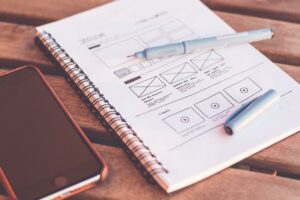Nowadays, a website works as an integral part of creating and promoting a business. Its purpose is to attract more customers, increase conversions, and, as a result, enlarge profits. But the site creation consists of many tasks, from a comprehensive analysis of the target audience to choosing a color scheme. A high-quality design means that the site is useful and understandable, as the user quickly finds the information he or she needs. It also allows you to receive feedback from the consumer and determine growth points for your business.
Site Structure
When creating a site, you need to focus on its convenience for the user and provide easy navigation between its pages and elements. Each page should be dedicated to one specific action and created without unnecessary items. There should be a form to fill out on the registration page; a list of answers and questions should be published in the FAQ section, and the user should be able to find all possible phone numbers, email addresses, and other details in the corresponding tab.
The fundamental element – the menu – should be navigable and accessible from all pages and contain links to all main sections. The menu visually reflects the site structure and helps the user navigate between the sections quickly. It would also be nice to think about implementing a search box, filters, and sorting features to make the user experience even more easy-flowing.
The same goes for attached media. If it’s an inserted video, it must be coherent and include captions for better comprehension. An inserted image, in turn, must be accurate and of high quality; any blunder, like an inappropriate background, would diminish the image’s value. Fortunately, the Blur Background Pictures feature provides quick solutions to graphic issues and helps bolster the entire visual aspect, allowing experts to move to other page-related matters promptly.

Element Hierarchy
It is necessary to determine the priority of each element on a web page and place corresponding accents. The most valuable information should stand out. To that end, you can play with the content arrangement on the page, its font sizes (larger or smaller), and additional visual effects (videos, images, icons). As practice shows, it is worth making one intuitive focus point on the page. For instance, action buttons should be made highly visible and contain a clear description of their purpose. Any additional but non-essential information is usually placed at the bottom, but do not refuse it either, as details are important for users.
Think of negative space as something positive. Users do not like cluttered pages — simplicity and clarity are more important. White space is not only responsible for readability and content prioritization but also plays an important role in visual design. It can also simplify the work of a UI specialist.
Mobile Version
When developing a website, you have to take care of both desktop and mobile users. Missing this aspect can lead to a decrease in the site’s rating, and, as a result, to a drop in the number of potential customers and the amount of profit. For many search engines, mobile-friendliness is one of the key items in generating SERPs.

Speed
One of the most important ranking factors for search engines is the assessment of a platform’s full load speed. This technical indicator directly affects the site position. After all, no one likes to wait. If a web resource is not opened within 2 seconds, users are likely to leave it. And a greater number of dissatisfied visitors results in fewer interactions and less successful promotion. Therefore, the main task is to implement visual components and functional elements of a site in such a way that they affect the loading speed as little as possible.
Testing
Any UX professional should conduct usability testing before launching a site. Simply put, it is a method of evaluating an interface in terms of the convenience and efficiency of its use. With it, you can find out what problems arise in the work and how the product meets the expectations of users.

Representatives of the target audience are involved in testing to obtain such data. As a rule, usability testing is carried out in two stages: the users complete a series of tasks and then fill out questionnaires or undergo an in-depth interview. This whole process starts when the resource is ready to be launched, or when the interface has been created as a paper/digital prototype. The duration of testing depends on the complexity of scenarios and the availability of their alternatives, the number of user roles, and other factors.
Final Word
It is worth saying that the task of UX designers goes beyond just creating a website. They analyze the interests of both the business owner and the user and develop the basis of the project. By creating a high-quality digital product, they are the key to loyal, regular customers originating from users who once enjoyed interacting with the site.
